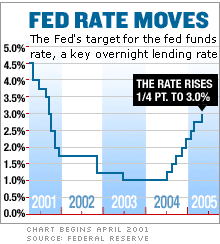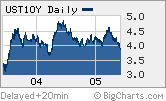 |
 |
| The yield on the 10-Year Treasury is at its lowest point in more than a year...even though the Fed has raised short-term rates eight times since last June. |
|
|
|
|
|
| More about the Fed and economy
|
|
|
|
|
|
|
NEW YORK (CNN/Money) – This week's big news was that the identity of Watergate mole Deep Throat was finally revealed.
Keeping with this 1970s theme, many market observers think Alan Greenspan & Co. still want to Whip Inflation Now, like Gerald Ford.
That should mean more interest rate hikes this year, despite some recent chatter about the Fed possibly pausing, perhaps as soon as its Aug. 9 meeting.
"I think the Fed is going to continue to hike. The economic outlook is not as hot as it was last year but we don't see evidence of a materially slower second half," said Steve Van Order, chief fixed income strategist with Calvert Funds. "Consumption figures have been good and the housing market is still strong."
Sure, some fears about a slowdown were rekindled after a key report showed growth in manufacturing last month was the slowest since June 2003. The Wednesday report helped send the yield on the benchmark U.S. 10-Year Treasury to 3.89 percent, the lowest since April of last year.
With yields this low, bond investors are clearly betting that an economic soft patch is more of a concern than inflation, which is typically associated with a hot economy.
In addition, Dallas Federal Reserve Bank president Richard Fisher said in two published interviews Wednesday that the Fed could be close to ending its series of rate hikes.
The central bank has raised short-term rates by a quarter of a percentage point at its last eight meetings. The next meeting is set for June 29-30 and Fed policy-makers are widely expected to boost rates another quarter-point, bringing their target for the federal funds rate, on overnight bank lending rate, to 3.25 percent.
Eyes on inflation
But it would be foolish to think that the Fed's inflation vigil, and hence its practice of raising rates at a "measured" pace, is nearly over. It just may be that the Fed no longer needs to consider raising rates by more than a quarter of a point of a time.
"I don't think the Fed is under pressure to raise rates faster than they have been but I think they'd be crazy to think that they should be done tightening," said Bill Cheney, chief economist with John Hancock Financial Services.
After all, there is some evidence that wage pressures are picking up -- something Greenspan & Co. watch very closely.
To that end, revisions to the first quarter productivity report from the Labor Department Thursday showed a bigger-than-expected gain in unit labor costs. And in the April jobs report, wage gains rose at greater than anticipated rate and the number of new jobs added was much higher as well.
And if there is similar strength in the May numbers due Friday, it would seem the Fed would have more than enough ammunition to justify more rate increases. Economists are predicting that employers added 178,000 jobs to payrolls in May and that wages grew at a 0.2 percent clip.
Jack Ablin, chief investment officer with Harris Private Bank, thinks that a very strong payroll number would spook the bond market and drive yields higher, as fixed-income investors would have less reason to believe the Fed is ready to stop anytime soon.
"If there is anything more than 250,000 jobs then everything reverses and all bets about a pause at 3.25 percent are off," Ablin said.
Bond prices and yields move in opposite directions.
What is neutral?
Still, even if the jobs report is not incredibly robust, many believe the Fed still plans to keep raising until rates reach a "neutral" level, especially since long-term rates are very low, which Greenspan has called a "conundrum."
Many Fed watchers say "neutral" rates -- meant to spur growth but also curb inflation -- lie somewhere between 3.5 percent and 4.5 percent.
Ablin thinks the Fed could pause at 3.5 percent while Cheney thinks the Fed will keep raising until the fed funds rate is at 4 percent. And Van Order said the Fed might raise rates at every remaining meeting this year. If it does that, the fed funds rate would be at 4.25 percent by year's end.
The biggest wild card, however, depends on what the bond market does in the next few months. John Lynch, chief market analyst with Evergreen Investments, said the Fed is most interested in seeing long-term rates creep back up to minimize the risks of a bubble in the bond market -- and to help cool off what may be an overheated housing market.
So the Fed is clearly getting close to "neutral", Lynch said, noting if long-term yields end their slide and start rising soon, then the Fed may be able to pause sooner rather than later.
But if bond yields stay stubbornly low, Lynch thinks Greenspan might use his next appearance to Congress in mid-July to try to put some fear into bond investors. Remember, it was at Greenspan's semiannual testimony in February that Greenspan first mentioned the "conundrum," which promptly sent long-term yields higher.
"The Fed should be able to stop soon but if the long-end doesn't react then I wouldn't be surprised to see Greenspan come out guns blazing in Congress next month saying, 'Conundrum, conundrum, conundrum.' Fed statements have had more of an effect on the bond market than actions," Lynch said.
For more about the job market and how it affects you, click here.
For a closer look at the bond markets, click here.

|